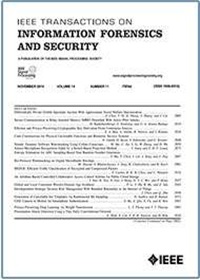TriAssetRank: Ranking Vulnerabilities, Exploits, and Privileges for Countermeasures Prioritization
IF 6.3
1区 计算机科学
Q1 COMPUTER SCIENCE, THEORY & METHODS
IEEE Transactions on Information Forensics and Security
Pub Date : 2024-10-30
DOI:10.1109/TIFS.2024.3488533
引用次数: 0
Abstract
Network defence practices have no standardized mechanism for determining the priority of threat events. Prioritization of cyber vulnerabilities intends to make network administrators focus on the most critical points within the system to mitigate potential damages produced by attackers. More likely, in managing vulnerabilities, current approaches always focus on the common vulnerability exposures (CVE), which are not the only existing vulnerabilities in a network. Also, while the Common Vulnerability Scoring System (CVSS) effectively scores individual vulnerabilities, it fails to consider the relationships between them but considers each vulnerability in isolation. Existing research, such as the ‘AssetRank’ algorithm, has made progress in exploring these relationships. Building on this foundation, in this paper we propose TriAssetRank, a tripartite ranking algorithm that evaluates three key elements within a logical attack graph: vulnerabilities, privileges, and potential attack exploits. Since each node type has its unique characteristics and potential impact on the system’s security, we rank them in concert, taking into account the dependencies between nodes in the attack graph. The proposed ranking scheme computes a numerical value for each node based on its type, which is a clear indication of how valuable it is to a potential attacker. Several tests on various model networks have empirically validated the effectiveness of the algorithm, which enables organizations to prioritize countermeasures by identifying the most critical vulnerabilities, exploits, and privilege escalation risks, allowing efficient allocation of resources to mitigate high-impact threats and reduce overall risk exposure effectively.TriAssetRank:对漏洞、漏洞利用和权限进行排序以确定对策优先级
网络防御实践中没有确定威胁事件优先级的标准化机制。确定网络漏洞的优先级是为了让网络管理员关注系统中最关键的点,以减轻攻击者可能造成的破坏。更有可能的是,在管理漏洞时,当前的方法总是关注常见漏洞暴露(CVE),而这并不是网络中唯一存在的漏洞。此外,虽然通用漏洞评分系统(CVSS)能有效地对单个漏洞进行评分,但它没有考虑到它们之间的关系,而是孤立地考虑每个漏洞。现有的研究,如 "AssetRank "算法,已经在探索这些关系方面取得了进展。在此基础上,我们在本文中提出了 TriAssetRank,这是一种三方排名算法,可评估逻辑攻击图中的三个关键要素:漏洞、权限和潜在攻击漏洞。由于每种节点类型都有其独特的特性和对系统安全的潜在影响,我们在考虑到攻击图中节点之间的依赖关系的同时,对它们进行协同排序。所提出的排序方案会根据每个节点的类型为其计算一个数值,从而清楚地表明该节点对潜在攻击者的价值。在各种模型网络上进行的多次测试从经验上验证了该算法的有效性,它使企业能够通过识别最关键的漏洞、漏洞利用和权限升级风险来确定应对措施的优先次序,从而有效地分配资源以缓解高影响威胁,并有效降低整体风险敞口。
本文章由计算机程序翻译,如有差异,请以英文原文为准。
求助全文
约1分钟内获得全文
求助全文
来源期刊

IEEE Transactions on Information Forensics and Security
工程技术-工程:电子与电气
CiteScore
14.40
自引率
7.40%
发文量
234
审稿时长
6.5 months
期刊介绍:
The IEEE Transactions on Information Forensics and Security covers the sciences, technologies, and applications relating to information forensics, information security, biometrics, surveillance and systems applications that incorporate these features
 求助内容:
求助内容: 应助结果提醒方式:
应助结果提醒方式:


